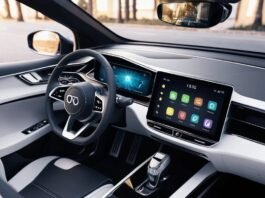Understanding the AI-Driven Workplace Transformation
The integration of artificial intelligence (AI) in businesses is transforming the traditional workplace landscape. As organizations adapt to an increasingly competitive environment, the necessity for enhanced productivity and efficiency has never been more pronounced. AI technologies are becoming essential tools that not only augment operational capabilities but also redefine how employees engage with their work and collaborate with one another.
One of the primary drivers of this transformation is the ability of AI to process vast amounts of data quickly and accurately. With the help of machine learning algorithms, businesses can analyze trends, forecast market shifts, and make informed decisions based on data-driven insights. This capability significantly minimizes human error and reduces the time spent on analysis, allowing employees to focus on more strategic and creative tasks that require human intuition and emotional intelligence.
Moreover, AI facilitates improved decision-making by providing relevant information and predictive analytics. For instance, AI-powered systems can assess various scenarios and recommend optimal solutions, streamlining workflows and enhancing efficiency across departments. As a result, workplaces are witnessing not just a shift in the efficiency of operations but also an improvement in overall employee satisfaction and morale, as workers are empowered to deliver higher-quality output without being burdened by repetitive tasks.
Collaboration among team members is also enhanced through the deployment of AI technologies. Tools such as chatbots and virtual assistants enable seamless communication, allowing employees to access information and assistance quickly, reducing bottlenecks in workflow. Additionally, AI platforms can facilitate better project management by automating scheduling, tracking progress, and analyzing team performance, ensuring that every team member is aligned and informed.
In summary, the advent of AI in workplaces is reshaping business operations, profoundly affecting productivity, decision-making, and teamwork dynamics. Embracing AI-driven transformations will be vital for organizations seeking to thrive in an ever-evolving marketplace.
The Importance of Modern Technology Integration
In today’s fast-paced business environment, integrating modern technology into the workplace has become not just beneficial, but essential for organizations seeking to thrive. The advent of cutting-edge technology presents numerous advantages, particularly in enhancing collaboration among teams and fortifying the security of sensitive information. By embracing these advancements, businesses can create an innovative atmosphere that fosters growth and productivity.
One of the primary benefits of modern technology integration is improved collaboration. Tools such as project management software, cloud storage solutions, and communication platforms facilitate seamless interactions among team members, regardless of their physical locations. For instance, applications like Slack and Microsoft Teams allow employees to communicate in real-time, share documents, and brainstorm ideas, leading to more effective teamwork and project execution. Such collaborative tools not only enhance workflow efficiency but also contribute to employee satisfaction, as they feel more connected to their colleagues.
Moreover, the protective capabilities of artificial intelligence (AI) further underscore the necessity of integrating technology in the workplace. AI-driven security measures can monitor systems for suspicious activities, offering a proactive approach to safeguarding sensitive data. Solutions such as biometric authentication and advanced encryption techniques help protect against unauthorized access, ensuring that confidential information remains secure. By prioritizing the adoption of AI technology, organizations not only bolster their cybersecurity but also instill confidence in their clients and stakeholders regarding the protection of their data.
To illustrate, companies have begun implementing AI-powered tools like Darktrace, which utilizes machine learning algorithms to detect anomalies in network traffic, enabling timely responses to potential threats. Such practical examples highlight the transformative impact of modern technology integration in the workplace. As organizations continue to recognize the critical role that advanced technology plays in enhancing both collaboration and security, the commitment to revamping their operational practices is paramount for success.
Upgrading Hardware for Future Compatibility
As businesses increasingly integrate artificial intelligence (AI) into their operations, the importance of upgrading hardware cannot be overstated. Modernizing your organization’s technology infrastructure ensures that it is compatible with the latest AI advancements, enabling optimal performance and extracting the maximum potential from innovative tools and applications. Investing in new devices tailored to support AI capabilities will position your workplace for enhanced productivity and improved competitive stature in an ever-evolving landscape.
One of the primary benefits of updating hardware is the improved efficiency it brings to operations. Older devices often struggle to run sophisticated AI algorithms, resulting in slower processing speeds and subpar performance. By upgrading to systems equipped with faster processors, increased memory capacity, and enhanced graphics capabilities, organizations can experience a significant boost in productivity. This leap in performance allows teams to utilize AI applications effectively, streamlining workflows and ultimately driving greater innovation within the company.
Another critical aspect to consider is the connection between upgraded hardware and user experience. Employees equipped with modern technology enjoy a more seamless and efficient working environment. Enhanced hardware can reduce downtime caused by technical issues and facilitate smoother interactions with AI-powered tools. The ergonomic design and advanced features of contemporary devices also contribute to improved employee satisfaction and morale, as users are better able to focus on their tasks without the frustrations of outdated technology.
Furthermore, investing in hardware that supports evolving AI capabilities prepares organizations for future technological advancements. As the landscape of AI continues to grow, having the right infrastructure in place will ensure that businesses can quickly adopt new solutions, maintain competitiveness, and respond promptly to market demands. By prioritizing hardware upgrades, companies lay a solid foundation for ongoing innovation, ensuring they are not left behind in an increasingly digital world.
Exploring AI Use Cases in the Workplace
Artificial Intelligence (AI) has become a cornerstone in enhancing workplace productivity and innovation across various industries. One of the most promising applications of AI is in automating repetitive tasks, enabling employees to focus on higher-value activities. For example, customer support teams can leverage AI-driven chatbots that handle basic inquiries and troubleshoot common issues. This not only streamlines customer interactions but also reduces the workload on human agents, allowing them to concentrate on more complex queries that require personal engagement.
Another notable instance of AI application is in data analysis and decision-making processes. Utilizing machine learning algorithms, businesses can sift through vast amounts of data to identify patterns and trends. This capability empowers managers to make informed decisions based on real-time analytics rather than relying solely on intuition. Industries such as finance and marketing have notably benefited from these AI insights, transforming how strategies are conceived and implemented.
In the realm of recruitment, AI tools have been developed to cleanse resumes, rank applicants based on fit, and even conduct initial assessments through virtual interviews. By employing such technology, companies can significantly reduce the time and resources spent on the hiring process while also increasing fairness in candidate evaluation. AI’s role in human resources is a prime example of how generative AI (genAI) can drive innovation by streamlining operations and enhancing overall efficiency.
Furthermore, the integration of AI in project management tools allows for better resource allocation and task management. By predicting project timelines and identifying potential bottlenecks, these intelligent systems enable teams to work collaboratively and with greater precision. This not only boosts individual performance but also enhances team productivity by fostering a more organized working environment.
As businesses seek to implement these innovative AI use cases, it is essential to foster a culture that embraces technology. Training sessions aimed at familiarizing employees with AI tools and promoting a mindset that welcomes change will prove beneficial in leveraging the full potential of AI in the workplace.




